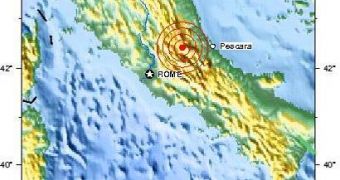At 3:32 am local time (9:30 pm, April 5th EDT) on Monday morning, a 6.3-magnitude earthquake struck the central part of Italy, causing important damages to buildings and numerous losses of human lives. Because the tremor happened at night, people were understandably taken by surprise, and many could not come to their senses and get out of the houses in the ensuing confusion. The epicenter of the devastating earthquake was near the city of L'Aquila, a medieval town about 70 miles (110 kilometers) Northeast of the Italian capital of Rome.
According to the most recent estimates, more than 90 people lost their lives in the devastation, with 1,500 more left injured or trapped inside buildings. At this point, it's still unknown how many were left homeless, but conservative estimates place that number in the thousands. Authorities say that this has been the most powerful tremor that the country has recorded over the past three decades, and that the event took everyone by surprise.
“This is a really complex region,” United States Geological Survey (USGS) seismologist Stuart Sipkin explained as quoted by LiveScience. He shared that foreshock – smaller tremors that occurred before the big one – were recorded three to five hours before the main event. “We certainly see foreshocks. It's not real common, but it's not uncommon either,” the expert added.
The tectonic processes in the region are very complex, geologists agree. Outside of the larger Euroasian and African plates, which are colliding in the Mediterranean, and that have already given birth to the Alps, there are also two micro-plates active in the region. The Adria plate is currently moving underneath the lighter Apennines one, following an East to West course, while the movement of the larger plates is on the North-South axis.
The seismic-active area saw another similar tremor in 1997, when a 6.0-degree earthquake struck relatively close to the current one. More than 80,000 were left homeless after the cataclysm, which mostly claimed old buildings, of which countless exist in the area. That event was, however, smaller than this one, killing just 11 and injuring a little over 100. Now, authorities are struggling to bring the situation under control, while at the same time preparing for the after-shocks that may or may not come.

 14 DAY TRIAL //
14 DAY TRIAL //